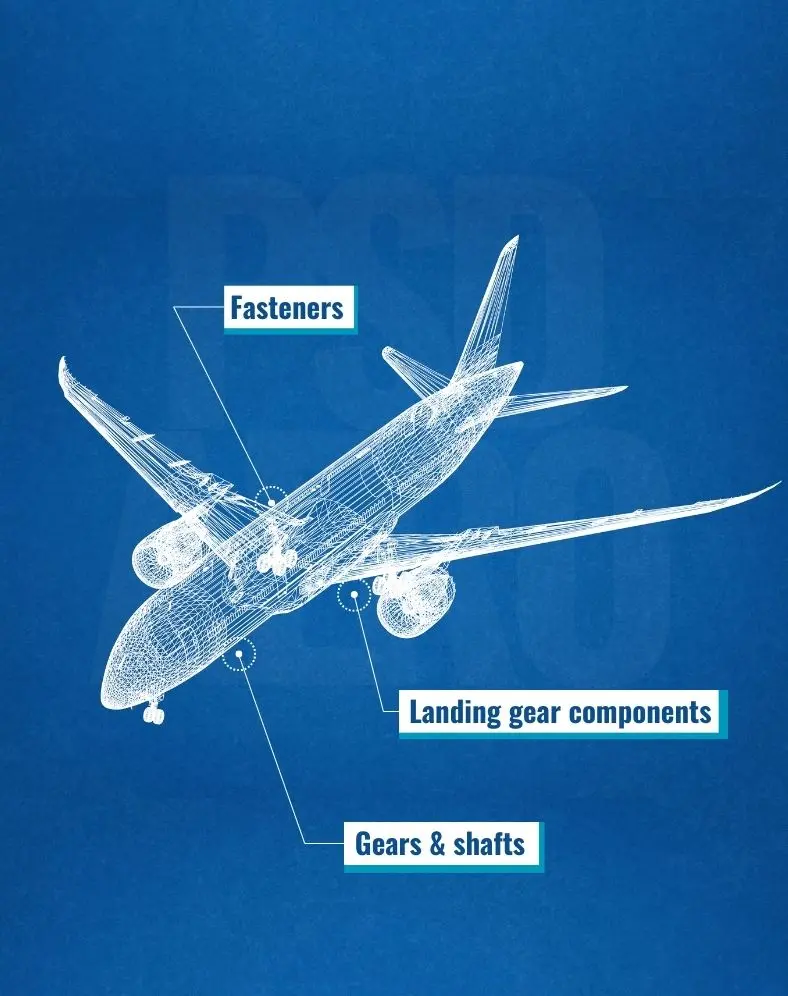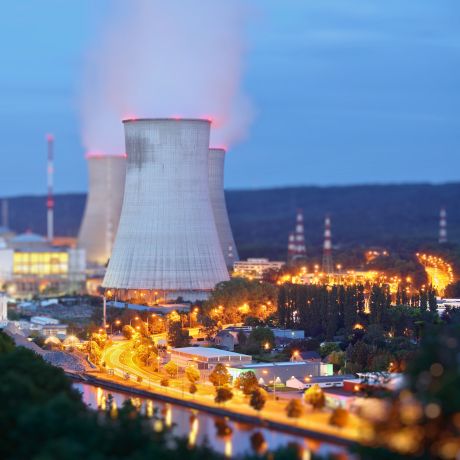Stainless steel 17-4PH - 1.4548 - UNS S17400 - AMS 5643 - AMS 5622 - S17400
17-4PH stainless steel combines high mechanical strength, durability at elevated temperatures, and versatile usability. Highly valued in demanding sectors such as aerospace, medical, and energy industries, this martensitic precipitation-hardening alloy is well-suited for components subject to significant mechanical stresses requiring corrosion resistance. Discover everything you need to know about the properties, heat treatments, machinability, and key industrial applications of 17-4PH stainless steel.
Available shapes :
Order 17-4PH Online
Select the desired form, standard, or specification and place your order with one click. A member of our sales team will contact you promptly to finalize your order.
Everything You Need to Know About 17-4PH Stainless Steel
Like all stainless steels, the chromium present in 17-4PH allows the formation of a passivation layer on the metal's surface, granting it resistance to oxidation and rust. This martensitic PH ("Precipitation Hardening") steel alloy undergoes heat treatment through solution treatment followed by aging and offers good corrosion resistance and high-temperature performance up to 316°C. It hardens during aging, unlike QT-type (Quenched and Tempered) martensitic steel, which reaches its peak hardness after quenching and is softened by tempering.
Heat Treatments
The mechanical properties of 17-4 PH are achieved through a two-step heat treatment. Solution treatment (Condition A) involves heating the alloy to approximately 1040°C, then quenching it to obtain a relatively soft martensitic structure. Aging, performed at lower temperatures (between 480°C and 620°C) for varying durations, causes the precipitation of fine particles that harden the material.
Different aging conditions (H900, H1025, H1075, H1150, etc.) each offer different trade-offs between strength, ductility, and corrosion resistance. For example, the H900 condition provides maximum strength and hardness, while the H1150 condition prioritizes corrosion resistance and ductility.
Mechanical and Chemical Properties
After precipitation hardening, 17-4PH steel can achieve a tensile strength of up to 1552 MPa, a yield strength exceeding 1236 MPa, and a hardness of 444 (HB).
While it has good corrosion resistance in many environments for a martensitic stainless steel, 17-4PH has certain limitations. It is generally less resistant than austenitic stainless steels such as 304 or 316, but close to them in chloride-containing environments (such as seawater). The choice of heat treatment condition significantly influences corrosion resistance, with lower hardness conditions generally offering better resistance but at the expense of mechanical properties.
Machinability and Weldability
The 17-4PH grade has good machinability, influenced by its heat treatment condition. In Condition A, it is comparable to that of some austenitic stainless steels, exhibiting some adhesion to cutting tools.
After aging, its increased hardness requires more robust tools, reduced cutting speeds, and effective cooling.
Finally, this grade can be welded using most processes. Welding is preferably performed before aging to avoid weakening the heat-affected zone.
It can also be forged through hammering, pressing, rolling, extrusion, or upsetting to produce a wrought structure. For maximum hardness, a re-solution treatment should be considered.
Industrial Applications
Thanks to its mechanical properties and corrosion resistance, 17-4PH steel is commonly used in:
- The aerospace industry
- The medical and surgical industry
- The chemical, oil, and gas industry. Tooling and prototyping (pump wheels, pipes, and valves), gas turbine components.
- The automotive industry
- Defense and firearms, etc.
Chemical composition of 17-4PH
The variations in its chemical composition for aerospace.
| % | Al Aluminium | C Carbon | Cr Chromium | Cu Copper | Mn Manganese | N Nitrogen | Nb Niobium | Ni Nickel | P Phosphorus | S Sulfur | Si Silicon | Sn Tin |
|---|---|---|---|---|---|---|---|---|---|---|---|---|
| Min. | <0.00 | <0.00 | 15.50 | 2.80 | <0.00 | <0.00 | 0.15 | 3.60 | <0.00 | <0.00 | 0.50 | <0.00 |
| Max. | 0.05 | 0.06 | 16.70 | 3.50 | 0.70 | 0.05 | 0.40 | 4.60 | 0.025 | 0.025 | 1.00 | 0.02 |
Related stainless steel alloys
15-5PH, 1.4545, X5CrNiCu15-5, EZ5CNU15.15
RECTANGULAR BAR, ROUND BAR, PROFILE, SHEET
17-7PH, S17700, 1.4568, AISI 631, X7CrNiAl17-7
SHEET
21-09-06, AMS 5561, Nitronic 40, S21900, X2CrMnNi21-6-9, Z4CMN 21-9-6
ROUND TUBE
AISI 301, Z12CN18-07, X12CrNi17-7, X10CrNi18-8
MOTHER COIL, COIL, SHEET
AISI 302, Z12CN18-09
SHEET
AISI 347, X6CrNiNb18-10, Z6CNNb18-10
RECTANGULAR BAR, ROUND BAR, SHEET, ROUND TUBE
AISI 431, APX, X15CrNi17-03, Z15CN17-03
SQUARE BAR, RECTANGULAR BAR, ROUND BAR, SHEET
AISI 446
ROUND BAR
CALE PELABLE
SHEET
CUSTOM 465, MLX17, X1CrNiMoAlTi12-11
ROUND BAR
EZ100CD17
ROUND BAR
EZ12CNDV12
ROUND BAR
EZ15CN17-03
ROUND BAR
EZ1CNDAT12-09, MARVALX12, X1CrNiMoAlTi12-9
ROUND BAR
EZ2NKD18-8-5, MARAGING 250, X2NiCoMo18-8-5
RECTANGULAR BAR
EZ3NCT25, X3NiCrTi25
ROUND BAR, COIL, SHEET (THICKNESS > 6MM)
EZ6CND16-05-01
SQUARE BAR
EZ6NCT25, A286, X6NiCrTi25
SQUARE BAR, RECTANGULAR BAR, ROUND BAR, COIL, WIRE, SHEET
EZ8CND17-04
ROUND BAR
GD223, X50NiMnCr12, Z50NMC12
ROUND BAR
PH13-8Mo, X3CrNiMoAl13-08-02, Z3CND13-08
RECTANGULAR BAR, ROUND BAR
S130
ROUND BAR
S143
ROUND BAR
S143D
ROUND BAR
S144
ROUND BAR
S145
ROUND BAR
X12C13, X12Cr13, AISI 410, 1.4006, Z10C13
ROUND BAR, SHEET
X30Cr13, Z30C13
ROUND BAR
X6Cr17
ROUND BAR
X750
SHEET
Z100CD17
ROUND BAR
Z12CN13
SHEET
Z12CNDV12, JETHETE M152, X12CrNiMoV12
ROUND BAR, SHEET
Z25CNWS22
ROUND BAR
Z2CN18-10, AISI 304L, X1CrNi18-10
RECTANGULAR BAR, ROUND BAR, COIL, WIRE, PROFILE, SHEET, PERFORATED SHEET, PVC SHEET, ROUND TUBE
Z6CND16-05-01, APX4, Z8CND17-04, X4CrNiMo16-5-1
ROUND BAR, SHEET
Z6CNT18-10, AISI 321, X6CrNiTi18-10, X6CNT18-10
SQUARE BAR, RECTANGULAR BAR, ROUND BAR, COIL, SHEET, ROUND TUBE
Key properties
The most remarkable properties of this stainless steel alloy
Tensile Strength
861.8–1552 MPa
Impact Toughness
≥ 25 J
Yield Strength
689.5–1236.6 MPa
Brinell Hardness
269–444 HB
How 17-4PH is used in aerospace
The practical applications of this stainless steel in aircraft construction.

Landing Gear Components
17-4PH steel is used for specific landing gear parts due to its excellent shock absorption capabilities. This alloy reduces the need for corrosion-protection treatments typically required for other high-strength steels.
Gears and Shafts
Transmission shafts, rotor axes, and gears made of 17-4PH benefit from high hardness, ensuring reliability under significant mechanical stress. These properties make it a suitable choice for helicopter rotor hubs and shafts.
Fasteners
17-4PH is commonly used for manufacturing bolts, studs, structural fittings, and fasteners in aircraft and missiles, effectively assembling critical aerospace components.









